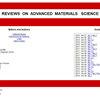带发热和热辐射的混合纳米流体在波浪形围护结构中的 MHD 对流的熵生成分析
IF 3.6
4区 材料科学
Q2 MATERIALS SCIENCE, MULTIDISCIPLINARY
引用次数: 0
摘要
这项研究探讨了混合纳米流体在热辐射、发热和磁流体力学中的流动和传热行为。该模型中的混合状态由两种不同的流体 TiO2(二氧化钛)和 Ag(银)表示。外壳呈波浪形倾斜,左右两侧为弯曲的墙壁。在对基本方程进行非尺寸化处理后,利用有限差分近似法求解基本方程,并将其进一步简化为四阶双谐波方程,然后根据双共轭梯度稳定法进行数值求解。模拟采用了不同的瑞利数、哈特曼数、外壳倾角、辐射参数、发热参数、磁场倾角和混合纳米粒子的体积分数。流线、等温线和平均努塞尔特数等线用于描述热流体模式。研究结果表明,平均努塞尔特数取决于ϕ,并且随着ϕ的增大而增大。研究结果表明,加热底壁的热量传递随着雷利数(Ra = 105 和 106)的增加而显著增加。在 45° 的空腔倾角处,观察到了有趣的多涡旋结构。这项研究的结果可能会提高太阳能集热器、热交换器和其他类似系统的效率,因为它们在自然界中依赖于对流热传递。本文章由计算机程序翻译,如有差异,请以英文原文为准。
Entropy generation analysis of MHD convection flow of hybrid nanofluid in a wavy enclosure with heat generation and thermal radiation
This work examines the behaviour of flow and heat transmission in the presence of hybrid nanofluid in thermal radiation, heat generation, and magnetohydrodynamics. The hybrid state in this model is represented by two different fluids, TiO2 (titanium dioxide) and Ag (silver). The enclosure is wavy and slanted, with curving walls on the left and right. The finite difference approximation method was utilized to resolve the fundamental equations after they were non-dimensionalized, which are further reduced to a fourth-order bi-harmonic equation and are numerically solved based on the biconjugate gradient-stabilized approach method. The simulations are performed with various Rayleigh numbers, Hartmann numbers, an inclination angle of the enclosure, radiation parameters, heat generation parameters, inclination angle of the magnetic field, and volume fraction of hybrid nanoparticles. The streamlines, isotherms, and average Nusselt number contours are used to depict the thermo-fluid patterns. The findings show that the average Nusselt number relies on ϕ and increases as ϕ rises. The investigation’s findings demonstrated that the transfer of heat on the heated bottom wall significantly increases with the Rayleigh number (Ra = 105 and 106 ). At a cavity inclination of 45°, interesting multi-vortex structures are observed. The results of this study may enhance the effectiveness of solar collectors, heat exchangers, and other similar systems that depend on convective heat transfer in nature.
求助全文
通过发布文献求助,成功后即可免费获取论文全文。
去求助
来源期刊

Reviews on Advanced Materials Science
工程技术-材料科学:综合
CiteScore
5.10
自引率
11.10%
发文量
43
审稿时长
3.5 months
期刊介绍:
Reviews on Advanced Materials Science is a fully peer-reviewed, open access, electronic journal that publishes significant, original and relevant works in the area of theoretical and experimental studies of advanced materials. The journal provides the readers with free, instant, and permanent access to all content worldwide; and the authors with extensive promotion of published articles, long-time preservation, language-correction services, no space constraints and immediate publication.
Reviews on Advanced Materials Science is listed inter alia by Clarivate Analytics (formerly Thomson Reuters) - Current Contents/Physical, Chemical, and Earth Sciences (CC/PC&ES), JCR and SCIE. Our standard policy requires each paper to be reviewed by at least two Referees and the peer-review process is single-blind.
 求助内容:
求助内容: 应助结果提醒方式:
应助结果提醒方式:


